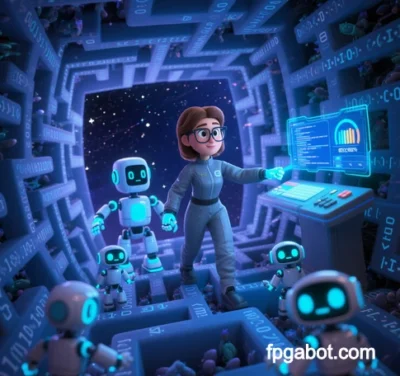
FPGA Bots vs. Traditional Medical Robots: Key Differences and Advantages (2025 Analysis)
FPGA (Field-Programmable Gate Array) Bots, leveraging reconfigurable hardware, differ fundamentally from traditional medical robots (typically CPU/GPU-based) in architecture, performance, and clinical applications. Below is a comparative analysis across four dimensions:
1. Hardware Architecture and Computing Paradigms
Hardware Reconfigurability
- FPGA Bots: Dynamically reprogrammable logic circuits enable hardware-level optimization for specific algorithms. For example, surgical robots adjust image-processing pipelines in real time to accommodate multimodal imaging (e.g., ultrasound-endoscope fusion).
- Traditional Robots: Fixed CPU/GPU architectures rely on software abstraction, limiting hardware utilization. The da Vinci system, for instance, requires external GPUs for imaging and cannot dynamically optimize computational paths.
Computing Models
- FPGA Bots: Dataflow-driven parallel processing handles hundreds of concurrent threads. ALINX surgical robots, for example, synchronize 8K video encoding, 3D reconstruction, and force feedback with microsecond-level latency.
- Traditional Robots: Von Neumann sequential execution faces memory bandwidth bottlenecks. Laparoscopic robots experience millisecond delays due to multi-stage pipelines (sensor→CPU→GPU).
2. Core Performance Advantages
Real-Time Responsiveness
- FPGA Bots: Achieve nanosecond-level response via hardware parallelism. Tactile endoscope robots execute force-control algorithms with 10μs sampling cycles, ensuring surgeon-robot synchronization.
- Traditional Robots: OS scheduling and bus latency introduce 5–20ms delays, risking tremor in orthopedic robot motion control.
Energy Efficiency
- FPGA Bots: Dynamic voltage/frequency scaling (DVFS) reduces power consumption to 1/5 of equivalent GPUs. Zynq UltraScale+ MPSoC processes 8K video at 8W vs. 40W for GPUs.
- Traditional Robots: High GPU power (>50W) necessitates bulky cooling systems, hindering portable/implantable designs.
Deterministic Computing
- FPGA Bots: Guarantee hard real-time performance under strict deadlines. Cardiac catheter robots complete path planning and execution within 1ms, avoiding jitter from task preemption.
- Traditional Robots: Soft real-time OS frameworks require redundant hardware to compensate for reliability gaps in high-risk scenarios.
3. Functional Flexibility and Adaptability
Multimodal Sensor Fusion
- FPGA Bots: Hardware-synchronized heterogeneous interfaces (optical, force, EMG) enable precise data integration. Neurosurgical robots combine fNIRS and EEG signals for real-time brain mapping.
- Traditional Robots: Software-based fusion suffers from bus bandwidth limits and interrupt latency, degrading accuracy.
Adaptive Algorithm Deployment
- FPGA Bots: Partial reconfiguration switches computing modules mid-procedure (e.g., tumor resection to vascular suturing) in 50ms.
- Traditional Robots: Algorithm updates require downtime or external hardware, disrupting workflows.
AI/ML Acceleration
- FPGA Bots: Custom neural accelerators (e.g., DSP slices) achieve <2ms polyp detection latency (98.7% accuracy) in colonoscopy AI systems.
- Traditional Robots: Cloud-dependent AI introduces >200ms delays (e.g., breast ultrasound diagnostics), compromising privacy and responsiveness.
4. Clinical Impact and Industrial Potential
Precision Interventions
- FPGA Bots: Enable submicron accuracy (0.1μm needle control in retinal injections), surpassing human steadiness.
- Traditional Robots: Mechanical/software errors limit precision (e.g., 50–100μm prostate surgery inaccuracies).
Cost Efficiency
- FPGA Bots: Remote updates extend device lifespans (e.g., 4K→8K endoscope upgrades via reprogramming).
- Traditional Robots: Hardware replacements drive costs (e.g., da Vinci Si→Xi upgrades exceeding $1M).
Safety Mechanisms
- FPGA Bots: Physically isolated safety circuits (e.g., radiation dose monitors) trigger emergency stops independently.
- Traditional Robots: Software-dependent safeguards risk malware bypass.
5. Challenges and Future Directions
Technical Barriers
- Skill Gap: Only 15% of medical engineers master HDL and spatiotemporal optimization.
- Immature Ecosystem: Lack of standardized medical IP cores (e.g., DICOM accelerators) prolongs development.
Emerging Trends
- 3D Heterogeneous Integration: Merging FPGAs with photonic chips and MEMS sensors creates self-aware surgical tools.
- Quantum-FPGA Hybrids: FPGA-managed qubit error correction could power molecular drug-delivery robots.
Conclusion
FPGA Bots, with their reconfigurable hardware, nanosecond precision, and energy efficiency, are redefining medical robotics. Their advantages in precision interventions, multimodal sensing, and cost-effectiveness position them as the future platform for complex surgical and therapeutic applications. By 2030, FPGA Bots may dominate >80% of high-complexity medical robotics scenarios as toolchain automation and specialized IP ecosystems mature.
Data sources: Publicly available references. For collaborations or domain inquiries, contact: chuanchuan810@gmail.com.
